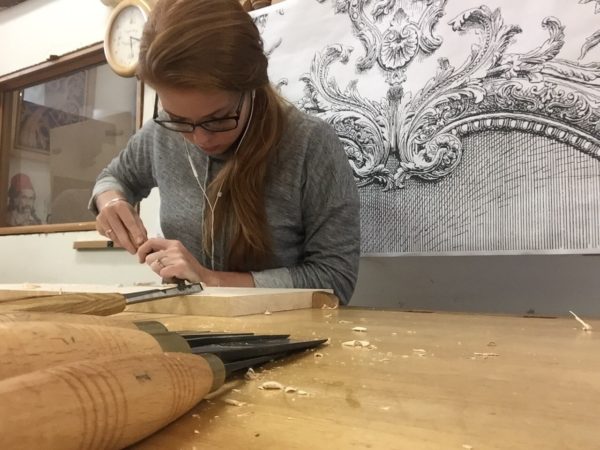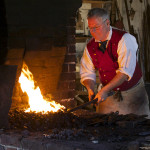 “One olive at a time.”
“One olive at a time.”
This phrase can be seen in several places around Master Dimitrios Klitsas’ workshop, be it in small font pinned to a cork board, in delicate watercolor as painted by one of his many students in thanks, or from the mouth of the master himself when it seems as though your project will take you a thousand years to complete. “It takes time. Go slow.”
In the region of Ioannina, Greece where Dimitrios is from, one of his daily chores was to pick olives from the abundant trees in his village. Looking out over the surrounding groves, he would think, “How will I ever pick all of these olives? There’s too many.”
Well, there’s only one way to do it, one olive at a time. It was a motto that stuck with him as he moved from Greece to America, made a name for himself as a gifted carver, and became a world-renowned master of the craft.
That habit he established in Greece all those years ago, of practicing patience and enjoying the task, translates to his talent as a Master woodcarver and is something he teaches the many students that pass through his doors to learn his craft.
Dimitrios Klitsas, front right, and son Spiro, front left, pose next to a replica 1902 piano collaboration with Steinway for a client overseas. The project took more than a year to complete, all carved using hand tools.
And the term “master” is not used lightly when speaking of his work. Dimitrios and his son, Spiro, run Klitsas Fine Woodcarving out of their home and workshop in Hampden, Massachusetts. Getting up before the sun and stopping well after dark, the two create masterpieces on commission as well as offer weekly classes and one to two-week intensive schools of carving. Students come from all around the country to listen and watch the master and his son as they carve bunches of grapes that look edible if not for their color, flowers that look like they were plucked and preserved from the sprawling farm out back, and mantelpieces or furniture fit for royalty.
Enter the Joinery apprentices. Peter Hudson, Scott Krogh, and I had the opportunity to travel to Massachusetts and study with the Klitsas family this August, and what an opportunity it was.
Thanks to the kindness and hospitality of the Klitsas family and the Colonial Williamsburg Foundation, several CW tradespeople have been able to stay and study with Dimitrios over the last decade, spending one or two weeks with Dimitrios, working long days and nights, absorbing as much information as possible. They return eager to apply those skills to better their respective programs in the Historic Area as well as growing professionally within their trade. Master Joiner Ted Boscana has spent collectively six weeks with Dimitrios over the years and wanted his students to have the same opportunity.
Peter, Scott, and I thoroughly enjoyed our time in Hampden. We worked hard, we listened, we carved. Learning to hold the tool correctly, how to sharpen a curved blade, how to translate a two-dimensional image and make it look as if it were moving: these were all important skills (among many, many others) we practiced and absorbed.
It is truly something to behold, watching a master at work. We would encounter a problem, a difficult place to remove material, a seemingly impossible image to reveal from the wood, and Dimitrios would walk over, take the tool, and make it so. “That was easy!” he would say with a laugh. (It was not easy.)
Carving, while not directly part of the Joinery trade in the 18th century, was certainly a skill that would expand a joiner’s business acumen and pocket book if learned and brought to their shop. Not every joiner was a carver, but it could certainly help your shop become more well-known and desirable if you could offer that service. Stair brackets, mantelpieces, and many other pieces of architectural finish work could be built and carved by the skilled joiner in the 18th century, and were highly fashionable among the wealthy the joiners catered to during the period. In the 21st century, carving taught (and continues to teach) our Joiners patience, the importance of sharp tools, and reading wood grain properly.
If you are interested in hearing more about the trip and seeing the apprentice’s first projects, as well as Ted’s pieces he completed under Dimitrios, do come by the Joiner’s shop and we would be happy to tell you all about it.
In one week, it is impossible to understand any trade or craft inside and out. It takes years and years of study, effort, failure, and victory. Countless hours of practice. Lots of consultation by those who came before you. But just like an apprenticeship, you take it one day at a time. We three apprentices have just begun to scratch the surface of Joinery, let alone the entirely new and complicated world of hand carving. Sometimes it may seem that there is just too much to learn, too many moving parts in any given project, too much we don’t know. Where do you even start?
You pick an olive. And then you pick another. And you keep picking them, one olive at a time.
GUEST BLOGGER: AMANDA DOGGETT
 Drawn here by the prospect of living history and preserving it for the future, Amanda can be found at the Talliferro-Cole House on Duke of Gloucester Street, where she has been an Apprentice Joiner since Spring 2016. She previously worked for Colonial Williamsburg’s Products division and has a degree in History from Christopher Newport University.
Drawn here by the prospect of living history and preserving it for the future, Amanda can be found at the Talliferro-Cole House on Duke of Gloucester Street, where she has been an Apprentice Joiner since Spring 2016. She previously worked for Colonial Williamsburg’s Products division and has a degree in History from Christopher Newport University.
Amanda lives in Yorktown with her fiancé, where they spend a lot of time outside. She is an avid runner who loves getting lost in a book or on a trail.

Leave a Reply